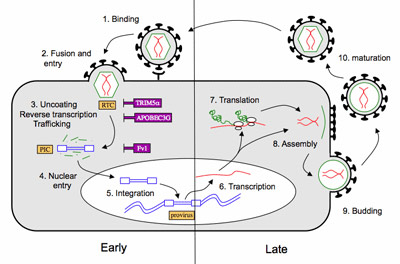retrovirus

The retroviral life cycle can divided into two phases, early and late. The stages in each phase are shown here.
A retrovirus is any of a large family of viruses (Retroviridae) that, unlike other living organisms, contain RNA as their genetic material. The RNA of the virus is translated, using a special enzyme (reverse transcriptase, see below) into DNA which inserts itself into an infected cell's own DNA. Retroviruses can cause many diseases, including some cancers and AIDS.
Interactions between viral and host cell factors occur at every stage of the viral life cycle, although many are still poorly understood. Identifying and understanding these interactions are key to developing new treatments to combat retroviral diseases.
Reverse transcription
This is a method of producing a double-stranded DNA copy of RNA from a virus. The technique is often used in genetic engineering to make DNA copies of messenger RNA (mRNA). It is achieved using the enzyme reverse transcriptase which occurs in retroviruses.


